Electrostatics I
- A plastic rod is rubbed with a dry piece of cloth and the rod becomes positively charged. The rod has ...
(A) gained electrons
(B) lost electrons
(C) gained protons
(D) lost protonsCorrect = B
Whether a body is positively or negatively charged depends only on the quantity of electrons this body is accommodating. Positively charged objects have lost electrons and negatively charged objects have gained electrons, hence number B is the correct answer.
- A negatively charged rod will ...
(A) always point north-south when freely suspended.
(B) attract a negative charge.
(C) repel a negative charge
(D) repel a positive chargeCorrect = C
Option C is correct: Like charges repel and unlike charges attract.
- \(P\) and \(Q\) are metal spheres hanging from nylon threads. When a negatively charged rod is brought between them - as shown in the diagram to the right - \(P\) is repelled and \(Q\) is attracted by the rod.
Which of the following statements is correct?
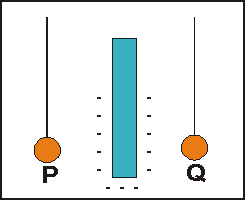
(A) \(P\) must be negative.
(B) \(P\) must be positive.
(C) \(Q\) must be negative.
(D) \(Q\) must be a conductor.Correct = A
Only a repulsive force between bodies is an indication that both bodies carry the same charge, correct A. NB: A charged object will induce charges in an uncharged object, consequently a force of attraction will be observed.
- There is an electrostatic force of attraction between any two of three metal spheres \(P,\) \(Q\) and \(R.\) A possible combination for the charges on \(P,\) \(Q\) and \(R\) is …
(A) \(P\) - positive \(Q\) - negative \(R\) - positive
(B) \(P\) - positive \(Q\) - negative \(R\) - neutral
(C) \(P\) - positive \(Q\) - positive \(R\) - positive
(D) \(P\) - neutral \(Q\) - positive \(R\) - neutralCorrect = B
Only in situation B is the electrostatic force attractive between all objects. Unlike charges attract (the pos. and neg. rods) and neutral objects become charged by induction when they are exposed to the field on a charged object. (see also explanation to question 3)
- Three metal spheres \(P\), \(Q\) and \(R\), on insulated stands carry charges as shown in the sketch. \(Q\) is now moved towards \(P\) and touches \(P.\) \(Q\) is then moved towards \(R\) and touches \(R\), after which \(Q\) is returned to its original position.
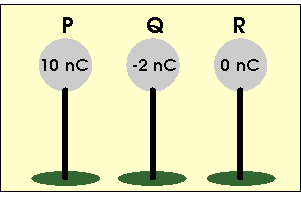
The charges on \(P,\) \(Q\) and \(R\) [in nC] are now …
Answer P Q R (A) + 4,0 nC + 4,0 nC + 4,0 nC (B) + 4,0 nC + 2,0 nC + 2,0 nC (C) + 6,0 nC + 3,0 nC + 3,0 nC (D) + 2,5 nC + 2,5 nC + 2,5 nC Correct = B
P and Q touch: +2 nC from P required to give Q a zero charge, leaving 8 nC on P which will be distributed equally on both charges. Hence Q has +4 nC after touching P. Now it touches R and after touching both spheres carry same charge of +2 nC.In option B we have the correct charge distribution.
- In an experiment 4 plastic Rods \(P, \;Q,\; R, \;S\) are used. Each rod may be charged or uncharged. In tests, it is found that \(P\) repels \(Q\) but \(R\) exerts no force on \(S.\)
These tests show that ...
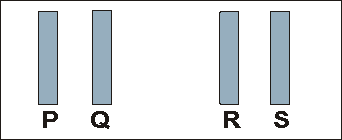
(A) \(P\) and \(Q\) are both positive.
(B) \(P\) and \(Q\) are both negative.
(C) \(P\) and \(Q\) have opposite charges.
(D) \(R\) and \(S\) are uncharged.Correct = D
From the given information me must conclude that only the D statement is 100% correct.
- Which of the diagrams below represents the effect of bringing a positively charged rod near (but not touching) an electroscope.
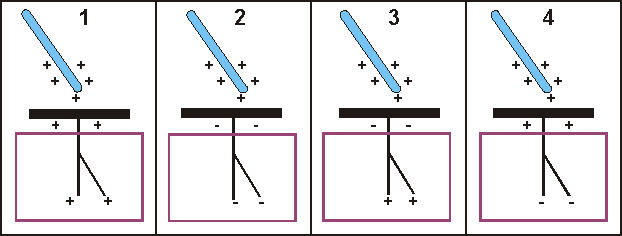
(A) 1
(B) 2
(C) 3
(D) 4Correct = C
The positively charged rod will induce negative charges in the upper part of the electroscope (electrons will flow towards the metal cap of the electroscope), which is shown in situation C.
- An electroscope is negatively charged, with the leaf at an angle of about \(45^\circ.\) When a negatively charged rod is slowly brought near the plate of the electroscope, the leaf ...
(A) rises.
(B) falls.
(C) rises then falls.
(D) falls to zero then rises.Correct = A
Unlike charges repel, hence the repulsive force between leave and metal plate/rod will increase causing the leave to rise even more.
- An electroscope is negatively charged, with the leaf at an angle of about \(45^\circ\). A metal ball on an insulating handle is slowly brought to (but not touching) the plate of the electroscope and the leaf falls.
This suggests that the metal ball is
(A) uncharged or positively charged.
(B) uncharged or negatively charged.
(C) positively charged.
(D) negatively charged.Correct = A
Only in situation A electrons will flow towards the top of the electroscope (and as a result the deflection of the leaf will decrease) either because of the presence of a positively charged body or because of inducing positive charges in the part of the sphere which is facing the negatively charged electroscope.
- A pear shaped conductor stands on an insulated base as shown in the diagram at the right.
If the conductor is given some charge at \(P\),
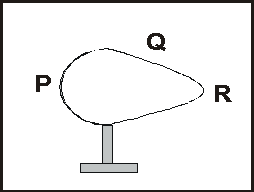
(A) all charge resides on the surface of the conductor.
(B) the charge distribution is equal all over the sphere.
(C) the charge density (amount of charge per unit area) is highest at \(Q.\)
(D) the charge density is highest at \(P.\)Correct = A
All charge given to a conductor resides on its surface, the charge density is highest at sharp points and there is no charge inside a hollow conductor.




